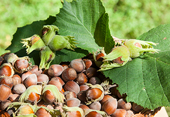One year on: What are the benefits of DCFTA for Georgia?
Monday, July 13

The sum of agricultural exports last year increased to reach 29 percent of Georgia’s total exports and for the first time agriculture products ranked third in Georgia’s export trade list. The volume of agricultural products increased by seven percent last year and brought the country $826 million USD in income.
Last year the export volume of nuts exceeded the export volume of wine for the first time, meaning nuts become Georgia’s main agricultural export product, according to data from Georgia’s Agricultural Ministry.
The new perspectives of Georgia’s agriculture sector have heavily influenced the country’s investment climate. This sector of the economy enjoyed direct investments worth $19 million USD in 2014, which was 61 percent more than the previous year, said Georgia’s Agriculture Ministry.
Agriculture was also largely funded by the Georgian Government – more than 27,000 farmers and farms utilised cheap agricultural loans worth 772 million GEL during the 2013-2014 years. The Agricultural Projects Management State Agency financed 105 new plants and an additional five were opened with the support of the Economy Ministry’s ‘Produce in Georgia’ program.
New manufacturing enterprises in the agricultural sector meant creation of additional value and this can be seen in numbers. Final products, worth 4.1 billion GEL, were created in the country as a direct result of processing initial products in 2014. This number was almost a 10 percent growth compared with the previous year.
The share of agricultural products in the country’s total GDP also rose in 2014 and was now 16.5 percent, latest figures showed. In previous years this figure peaked at 12 percent.
Exports to the EU increased by 109 percent in the past two years, compared to a growth rate of 46 percent for CIS countries, noted Geostat, Georgia’s state statistics service. Meanwhile, imports from Europe increased by 23 percent in the past two years, while there was a five percent drop in imports from CIS countries in the same time period. As a result, a negative trade balance reduced by $260 million USD, which meant that less foreign currency went out of Georgia.
While the expectation of the Deep and Comprehensive Free Trade Area (DCFTA) was to fulfill the Georgian market with EU products, the opposite happened; 12 months on from when the DCFTA was signed, Georgia’s imports from the EU grew five times less than Georgia’s exports to EU countries.
Internally, there were 1.3 million cattle last year in Georgia. This was an increase of six percent year-on-year. The number of pigs (units of pork) reached 210,000, which was an increase of 9.5 percent. A nine percent growth was also seen in poultry numbers, which reached 7.4 million.
The number of sheep and goats also increased last year by 1.2 percent and reached 867,000 units. The volume of meat production grew by one percent, reaching 49,000 tones, and milk production was 633 million litres in 2014, which was five percent higher than the previous year. As for egg production, this grew by five percent and reached 522 million in 2014.
Georgia signed the Association Agreement (AA) which includes DCFTA, on June 27, 2014.
(Agenda.ge)
